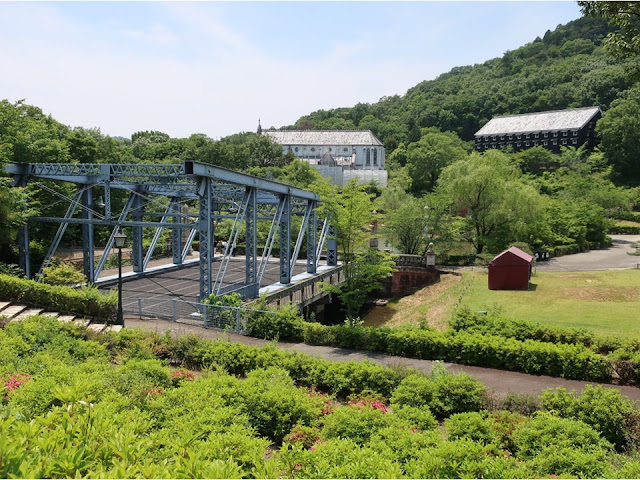“Meiji” means “Meiji period (1868-1912)”
and “Mura” means “village”. The huge open air architectural museum has
sixty-eight buildings built in Meiji period in which Japanese
modern era started. Although the European style buildings such as “Imperial Hotel”
(entrance hall) are popular, I focus on buildings for ordinary people such
as a theater and a public bathhouse; those are the theme of my blog (Fun of
Good Old Japanese).
The admission fees of the museums which I introduce
in this blog are free or a few hundred yen, however it of this museum was 2,500.
It was worth paying the fee because many buildings in the site (one million sqms)
and many volunteer guides brought me the Meiji period.
100万㎡の敷地に、全国の明治時代の建造物68施設を移築し、入館できるようにしています。帝国ホテルの玄関とロビーなどが目玉展示ですが、このブログでは、庶民が通った劇場や銭湯、移民として海外へ渡った人の家を紹介します。
私が訪問している博物館・資料館の入場料は無料か数百円ですが、ここは2500円(訪問時)。その価値ありです。ボランティアガイドさんもたくさんいて、見学を10倍楽しませてくれます。施設に入ると当時の人びとの思いが伝わってきます。
Buildings for ordinary people are moved to Area 4 above.
4丁目には、庶民が利用した建物が移築されています。
Public bathhouse in Aichi prefecture、半田東湯(愛知県)
It was built in around 1910. 1910年頃の竣工です。
Bathroom and dressing room. It says “There is only one bathtub (in the bathhouse), and a board screen separates the two sections (male and female) from above the water level”. It is a relic of the pre-modern era when mix bathing was common.
男性の更衣室と浴室には「浴槽は男湯と女湯がつながっており、目隠しだけで仕切られている」と書かれています。異性に裸を見せるのが恥ずかしくなかった時代の名残ですね。
The picture above shows “Saloon on the 2nd floor” in 1881 or 1882. It’s interesting! It is written only in Japanese, “Public bathhouse had been a crucial social gathering venue of a community since pre-modern period. Regular customers went to the 2nd floor after bathing and enjoyed chatting.” Some are naked.
二階の休憩室、おもしろい絵です。「銭湯は江戸時代以来、地域の社交場として欠かせない存在であって、湯上がりの常連客などは、二階に上がって雑談に時を過ごした」と書かれています。
Kureha-za Theater in Osaka prefecture、呉服(くれは)座(芝居小屋、大阪府池田市)
It was built in 1892 at the suburb of Osaka.
1892年竣工。池田市には伝説の織姫クレハトリが糸を染めたという井戸がありました。だからクレハと読むのでしょうか。
Ayumi(walking)-ita(board), on which waitresses delivered food and drink, are set. A free guide tour was held when I visited.
館内はガイドツアー中でした。給仕さんが食べ物や飲み物を運んだ通路(歩み板)も移設されています。
There are dozens of traditional theaters in Japan. Some are not listed such as “Izushi Eirakukan Theater"(<link). On the other hand, there are temporary theaters on which a traditional play like Kabuki is performed on a festival day. I hope those theaters remain and people enjoy performances; in many of them, actors are locals.
各地に現役の芝居小屋があります。兵庫県の永楽館(出石 永楽館 <リンク)など地図にはない小屋もあります。また、長野県の大鹿歌舞伎のように、祭りの日だけの公演がある舞台もあります。地域の文化として残っていって欲しいですね。
Barber shop in Tokyo、本郷喜之床(床屋、東京)
Ishikawa Takuboku (a great poet) rent the 2nd floor, then his first book of poems was published. The building was built in around 1910.
1910年頃竣工。石川啄木が2階を間借りしていたころに「一握の砂」が出版されました。
Ohi butcher shop and restaurant in Kobe、大井牛肉店(牛鍋屋併設、兵庫県神戸市)
Built in around 1887、1887年頃竣工
The shop initiated to sell beef to foreign sailors. Foreigner residential areas were limited back then; Kobe is one of them.
外国船に牛肉を提供したのが店の始まりだそうです。
The menu of forefront back then was “beef hot pot” on the table, which is a perfect example of Japanese food now. We started eating livestock meat after the Meiji period. You can eat beef hot pot (sukiyaki) on the second floor of this traditional building.
当時の最先端メニュー・牛鍋は、すき焼きに変化し、日本を代表するメニューになりました。この家の二階で食べられます(右下)。
Tomatsu House in Nagoya、東松住宅(名古屋市)
The wooden three-story building was a merchant residence. Several extension works were done; the third-story was constructed in 1901. There is full-scale tea ceremony facility on the 2nd floor, how chic it is! It was needed to be accompanied by a guide when I visited.
木造三階建ての商家です。再三の増改築を経て、三階以上は1901年増築されたようです。二階には待合付きの茶室(訪問時はガイドツアーでのみ見学可能)がある粋な家です。
In the inner most room (mainly for guests) on the 1st floor, models of cuisine on special day are displayed. Tomatsu family ate unrolled sushi (chirashizushi) on those days.
奥にある座敷にハレの日の食事が並べられていました。東松家ではちらし寿司が出されました。
Nakai Sake Brewery in Kyoto、京都中井酒造
A brewery built in 1870 was moved next to Tomatsu House. The photo above was a break room; a sake bottle and a Japanese chessboard are in it. We can feel the atmosphere when they worked.
お隣の「京都中井酒造(1870年竣工)」では、蔵人たちの休憩所も移築されています。一升瓶や将棋盤が置かれ、当時の雰囲気も再現しています。地下は麹室です。
Official website: https://centrip-japan.com/spot/meijimura.html
https://www.meijimura.com/
(in Japanese and much info.), accessed in Jun, 2025
Visited in May, 2024
Previous post (museum in the neighboring prefecture): Old
town of Mino City and its museums (2/2)、美濃の町と資料館(part2)
Next post (part 2 of this article): Meiji Mura (2/2) 、博物館 明治村(part2)
















Comments
Post a Comment